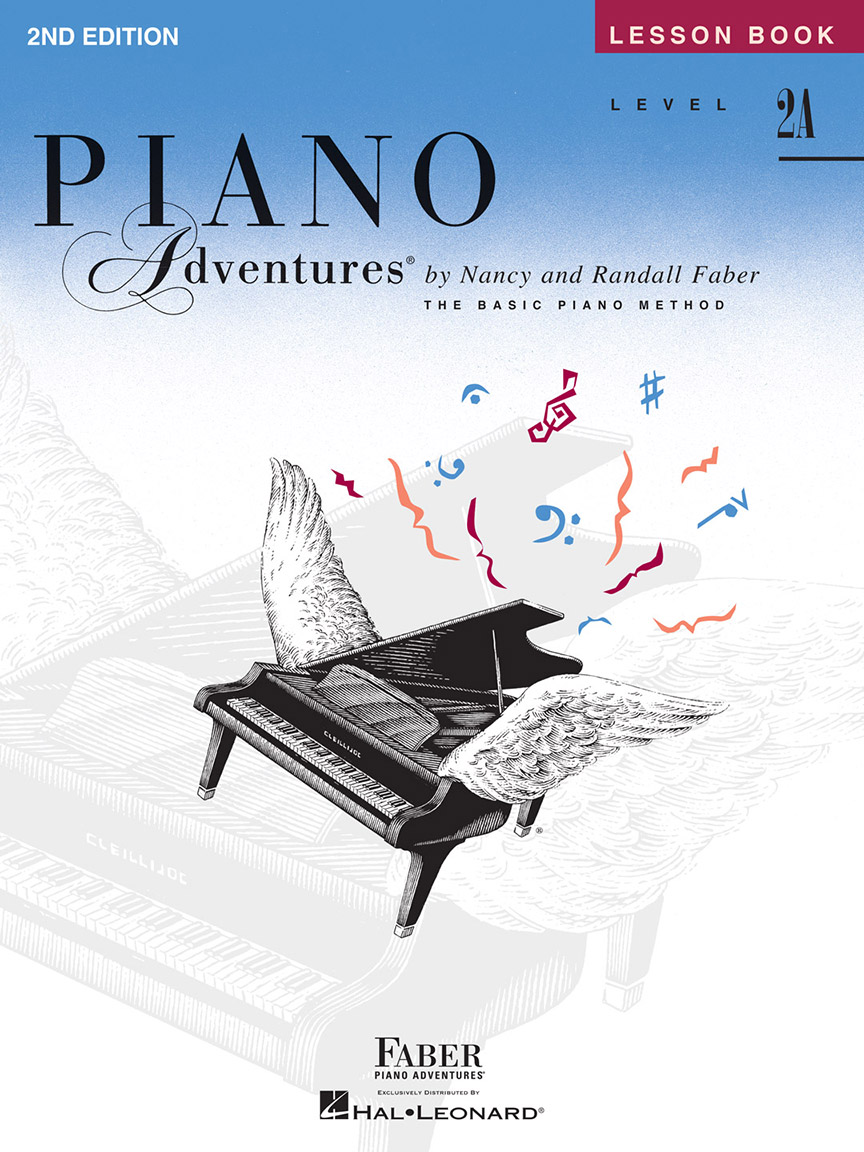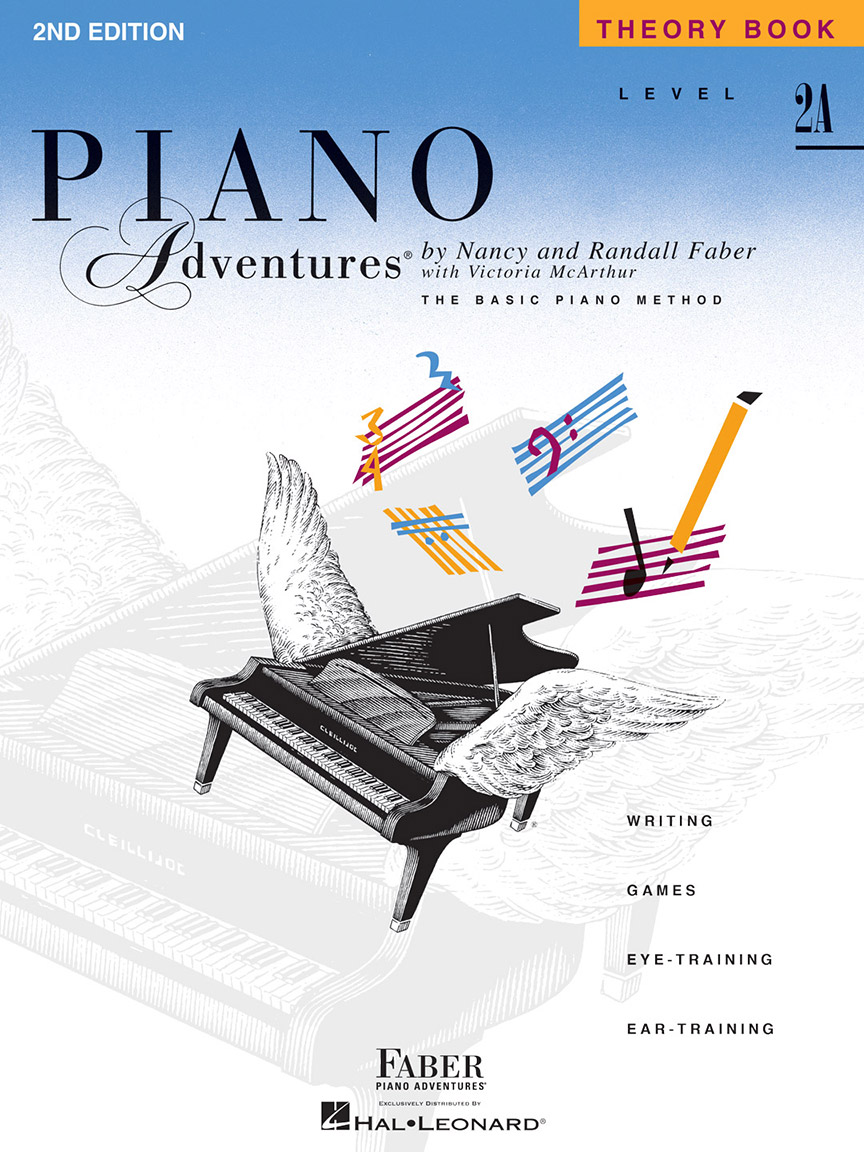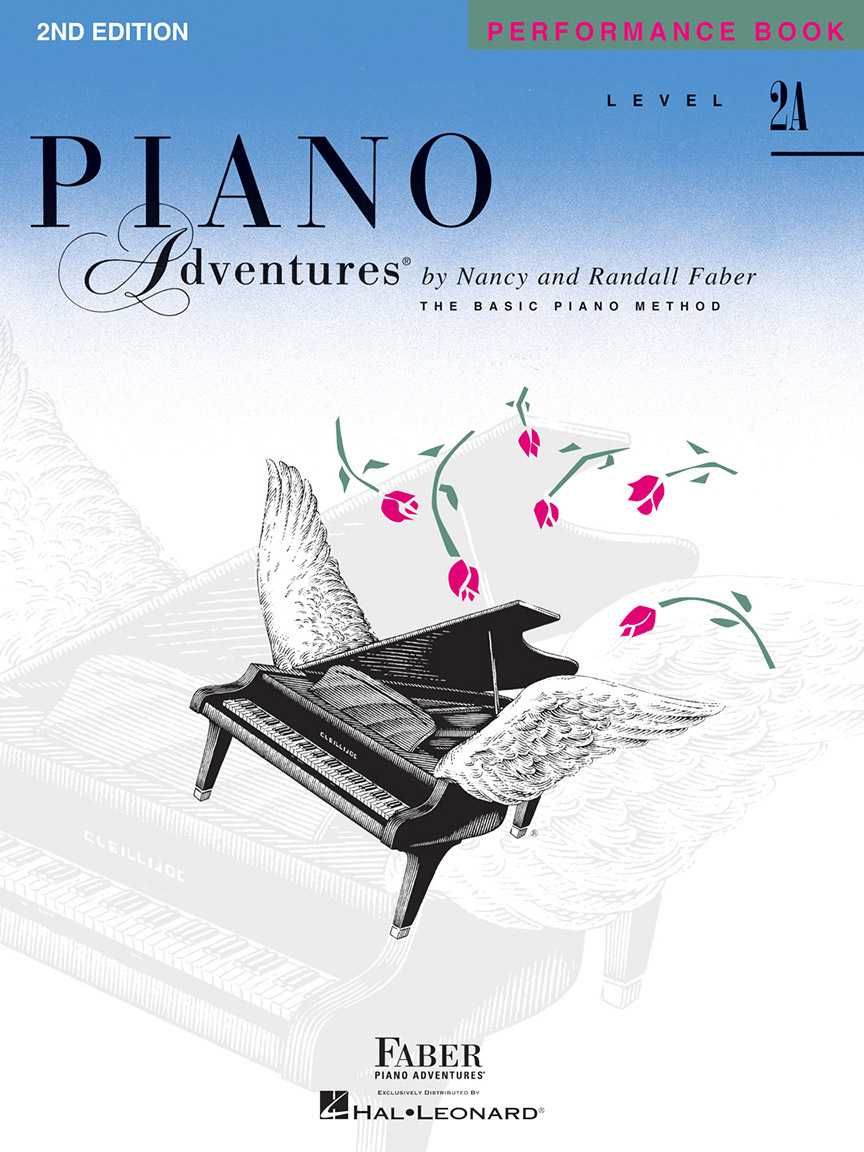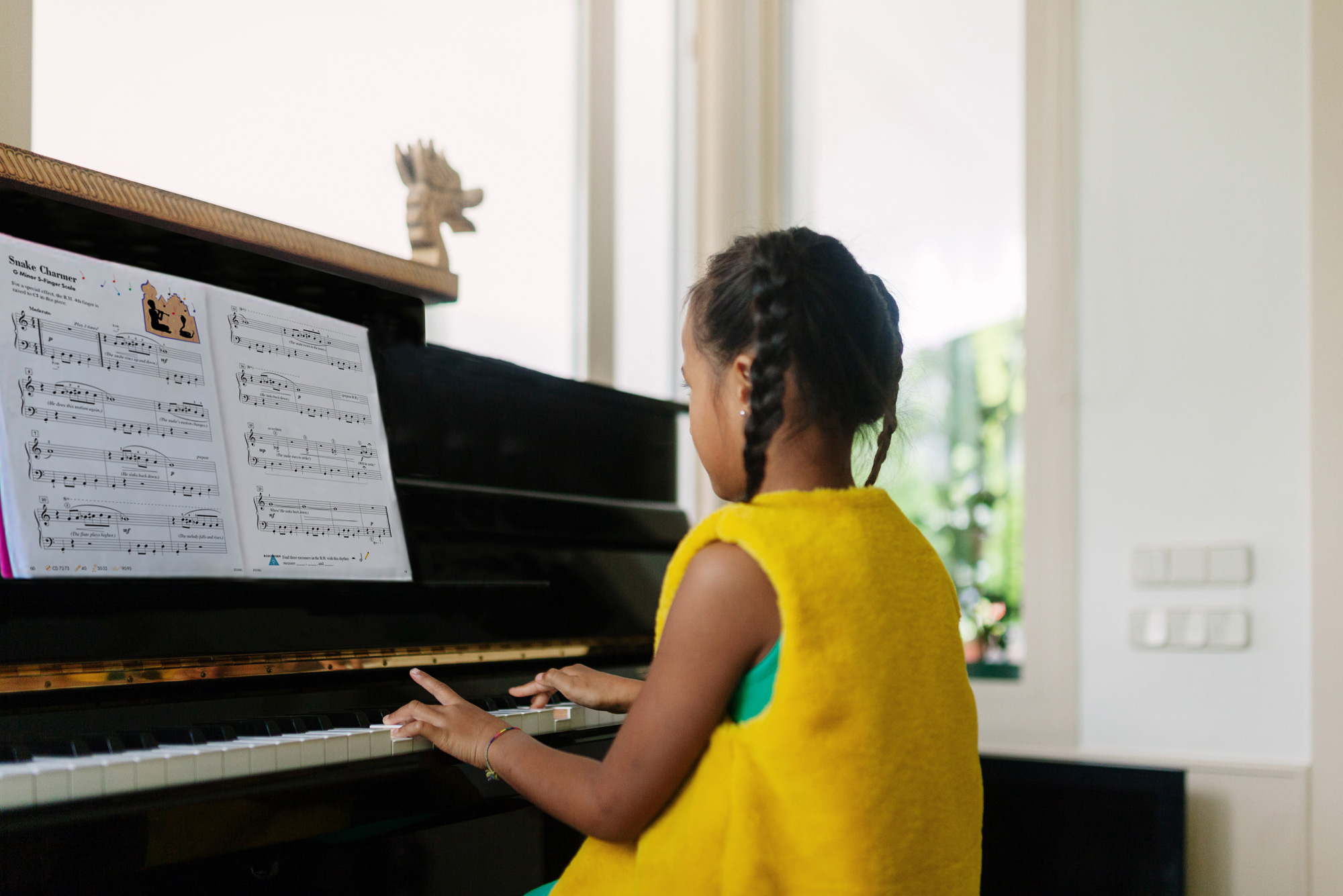
20Questions and Answers for Level 2A
About Level 2A Books
- The Level 2A Lesson Book starts with a Level 1 Review, “Get Ready for Take-off!” Is this important to do?
- Should I use all four core Level 2A Books: Lesson, Theory, Technique & Artistry, and Performance?
- How do I fit all four core books into a lesson?
- How should I use the “Treble Note Reading Guide” in the Lesson Book? (p. 6)
- How should I use the “Bass Note Reading Guide” in the Lesson Book? (p. 7)
- Why are 8th notes introduced at Level 2A and not before?
- What is the best way to count 8th notes for the 2A student?
- What is transposition and why is it important?
- How is the damper pedal used in Level 2A?
- How is the L.H. developed in Level 2A?
- The end of the Lesson Book has a Challenge Section showing all 12 major 5-finger scales. When should a student learn these? (pp. 62-63)
- What are the Technique Secrets and how do they help?
- When should I be using the 2A Sightreading Book and how?
About Level 2A Students
- Do students compose and improvise at Level 2A?
- What if a student has a poor sense of rhythm?
- What pieces could a 2A student play for extra fun?
- How important are recitals?
- Can I teach Level 2A students in an online lesson? What are some teaching tips?
About Level 2A Adventure Learning Videos
About Level 2A Audio Files
1. The Level 2A Lesson Book starts with a Level 1 Review, “Get Ready for Take-off!” Is this important to do?
The Level 1 Review that begins Level 2A is a handy teacher assessment tool. Use it for students graduating to Level 2A as well as transfer students. The Level 1 Review helps the teacher assess what is understood and what needs more support.
The two pages cover rhythm, time signatures, note reading, half steps, tonic and dominant, C and G 5-finger scales, I and V7 chords, staccato, legato, ritardando, sharp, flat, and slur.
Areas in which the student lacks confidence allow the teacher to “review and renew” understanding. Explore board work, flashcards, and cheerful questions and answers to review concepts together. Consider using the Level 1 Sightreading Book for students who need their reading skills strengthened as they begin Level 2A.
Level 2A Lesson Book
Get Ready for Take-off! (Level 1 Review, pp. 4-5)
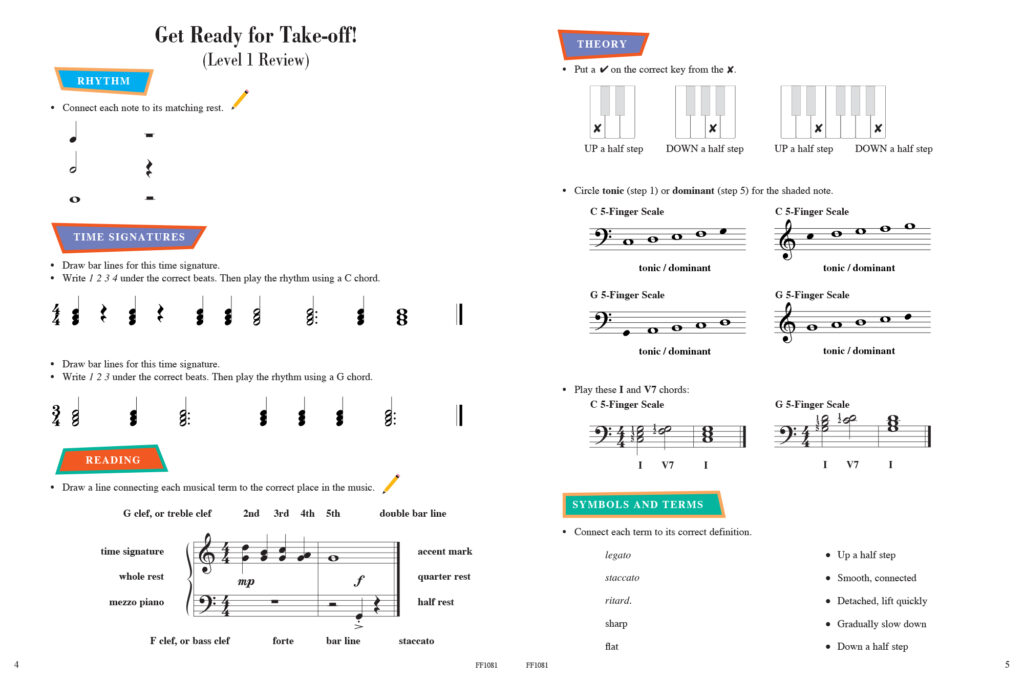
2. Should I use all four core Level 2A Books: Lesson, Theory, Technique & Artistry, and Performance?
The four core Level 2A Books form a set for wholistic learning and correlate by page number. The Theory, Technique & Artistry, and Performance Books give fresh perspectives for concepts in the 2A Lesson Book. It is possible a teacher could substitute a different solo book than the Performance Book. However, the precise tie-in of concepts in the core books is hard to beat. The elementary student is forming connections—connections that form the “musical mind”—and the more efficient these connections are made the better.
The core books address things easy to miss in lessons; ear-training, sightreading, improvisation, and importantly, technique from early lessons. Taking the time for deeper learning using the four core Level 2A Books prepares students for success in Level 2B.
3. How do I fit all four core books into a lesson?
The three most important books are the Lesson Book, the Theory Book, and the Technique & Artistry Book. A 30-minute lesson allows about 10 minutes per book. A 45-minute lesson offers a distinct time advantage for using all four books.
If time is short, consider demonstrating the Performance Book piece while the student watches the music. Give a few pointers, then assign to learn at home as your own “adventure piece.” This gives the teacher an opportunity to see what is easy and what is challenging at the next lesson.
For the Theory Book, the teacher might do the first example on a page with the student, then assign to complete at home. Parents can often help at Level 2A. With careful lesson planning and efficient use of lesson time, the four books can be implemented, even if one book is not covered in some lessons.
4. How should I use the “Treble Note Reading Guide” in the Lesson Book? (p. 6)
Level 2A continues with the goal of helping elementary students “read with ease.” Following the strategy of Level 1, this page presents 4 more “E-G-B-D-F Mouse Missions.” These activate a student’s fast response for all treble clef notes.
Students do these steps:
- Mission #1: Recite treble line notes, then space notes in order.
Recite the treble line notes quickly 3 times.
“E-G-B-D-F! E-G-B-D-F! E-G-B-D-F!”
Recite the treble space notes quickly 3 times.
“F-A-C-E! F-A-C-E! F-A-C-E!”
- Mission #2: Play treble line notes, then space notes in order.
Now play and name the treble line notes on the piano 2 times.
Next, play and name the treble space notes on the piano 2 times.
- Mission #3: Find treble line notes or space notes as requested.
The teacher calls out, “line 1” or “line 3,” etc. The student, thinking in “skips,” quickly finds and names the key on the piano. Next, the teacher calls out space notes, “space 1” or “space 4”, etc. The student, thinking in “skips,” quickly finds and names the key on the piano.
- Mission #4: Shade the letter names in the notes for a “solo flight.”
Teacher and student shade all the notes on the treble staff so the letter names disappear. The teacher points to any shaded note. The student quickly plays and names it on the piano. Set the reading strategy with “E-G-B-D-F” and “F-A-C-E.”
Level 2A Lesson Book
Note Reading Guide (p. 6)

5. How should I use the “Bass Note Reading Guide” in the Lesson Book? (p. 7)
This page now addresses the bass clef.
- Mission #5: Learn 5 bass line notes using “Smart Note” anchors.
Students review the 3 “Smart Notes” presented in Level 1: Bass line G, Middle line D, and Top line A. Strive for instant recognition. Now students learn the last two line-notes, bass line B and bass line F—each a skip away from a “Smart Note.”
- Mission #6: Shade the letter names in notes for a “solo flight.”
Teacher and student shade all the line notes on the bass staff so the letter names disappear. The teacher points to any shaded note. The student quickly plays and names it on the piano. Set the reading strategy with bass G, D, and A “Smart Notes.”
- Final Mission: Quick response for all bass clef notes
A set of 16 sample notes on the bass staff are given. The student names the closest Smart Note, then finds and names the note shown.
These activities become important note-reading strategies.
Level 2A Lesson Book
Note Reading Guide (p. 7)

6. Why are 8th notes introduced at Level 2A and not before?
Eighth notes are introduced in the opening pages of the Level 2A Lesson Book. The Primer Level and Level 1 do not use 8th-note patterns. Instead, these two levels emphasize a natural, rather quick pulse with quarter, half, dotted-half, and whole notes. This creates a more flowing approach to rhythm with emphasis to play “over the bar line.” The faster pulse produces natural, singable phrasing. All too often, if 8th notes predominate from the beginning lessons, the result can be a plodding, arhythmic sound—certainly something to avoid.
Once students have learned a basic set of notes and can maintain a strong, rhythmic pulse, then 8th notes are introduced formally in Level 2A with patterned songs, theory activities, and technique with five-finger scales and exercises.
7. What is the best way to count 8th notes for the 2A student?
Teachers may use a “combo approach” to count 8th notes at Level 2A.
- Syllables, such as “ta” for quarter notes and “ti-ti” for two 8th notes.
- Descriptive words, such as “walk” for quarters and “run-ning” for 8ths.
- Numbers for metric counting: 1 + 2 + 3 + 4 +
Now with 8th notes on the scene, routinely choose 4-8 measures of a piece to tap and count aloud with the student, subdividing the beat.
“1 + 2 + 3 + 4 +”
The teacher may model these measures and the student then imitates. Or, the student and teacher may tap and count aloud together.
This strategy creates an easier, “bite-sized” entrée into metric counting. Without laboriously counting the entire piece aloud, students can develop fluency with short, focused counting exercises.
Level 2A Lesson Book
8th Notes (p. 10)
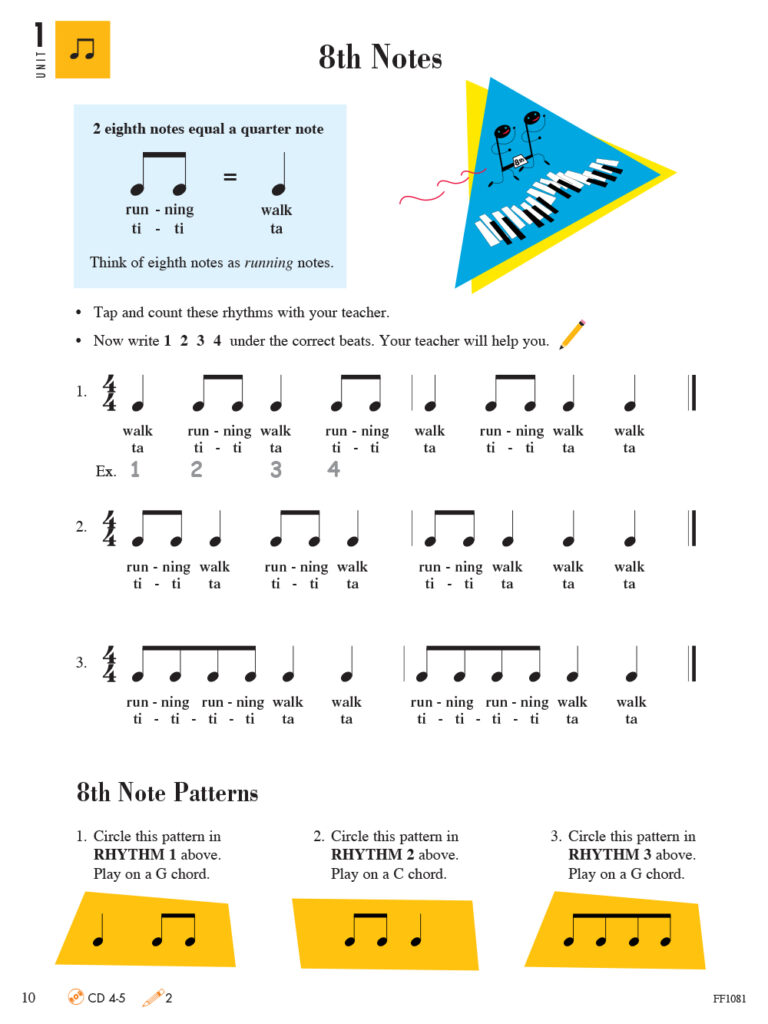
A Minuet for Mr. Bach's Children (p. 14)

8. What is transposition and why is it important?
The word “transpose” means to “put across or over.” For the Level 2A student, this means placing the hands across the keys, usually to another 5-finger scale.
The role of transposition in Level 2A yields important results.
- It highlights theory as students apply new scales to familiar pieces.
- It develops technique through repetition of patterns in other keys.
- It strengthens reading by interval.
Level 2A Lesson Book
Ice Cream, Mr. Haydn's Theme (pp. 18-19)

9. How is the damper pedal used in Level 2A?
Pedaling is used in Level 2A pieces to give touches of musical color, such as for an introduction or ending. Pedal is also held for the entire piece to create a sustained, impressionistic sound.
Level 2A Lesson Book
Whirling Leaves (pp. 46-47)

Level 2A Technique & Artistry Book
Malaguena (pp. 32-33)
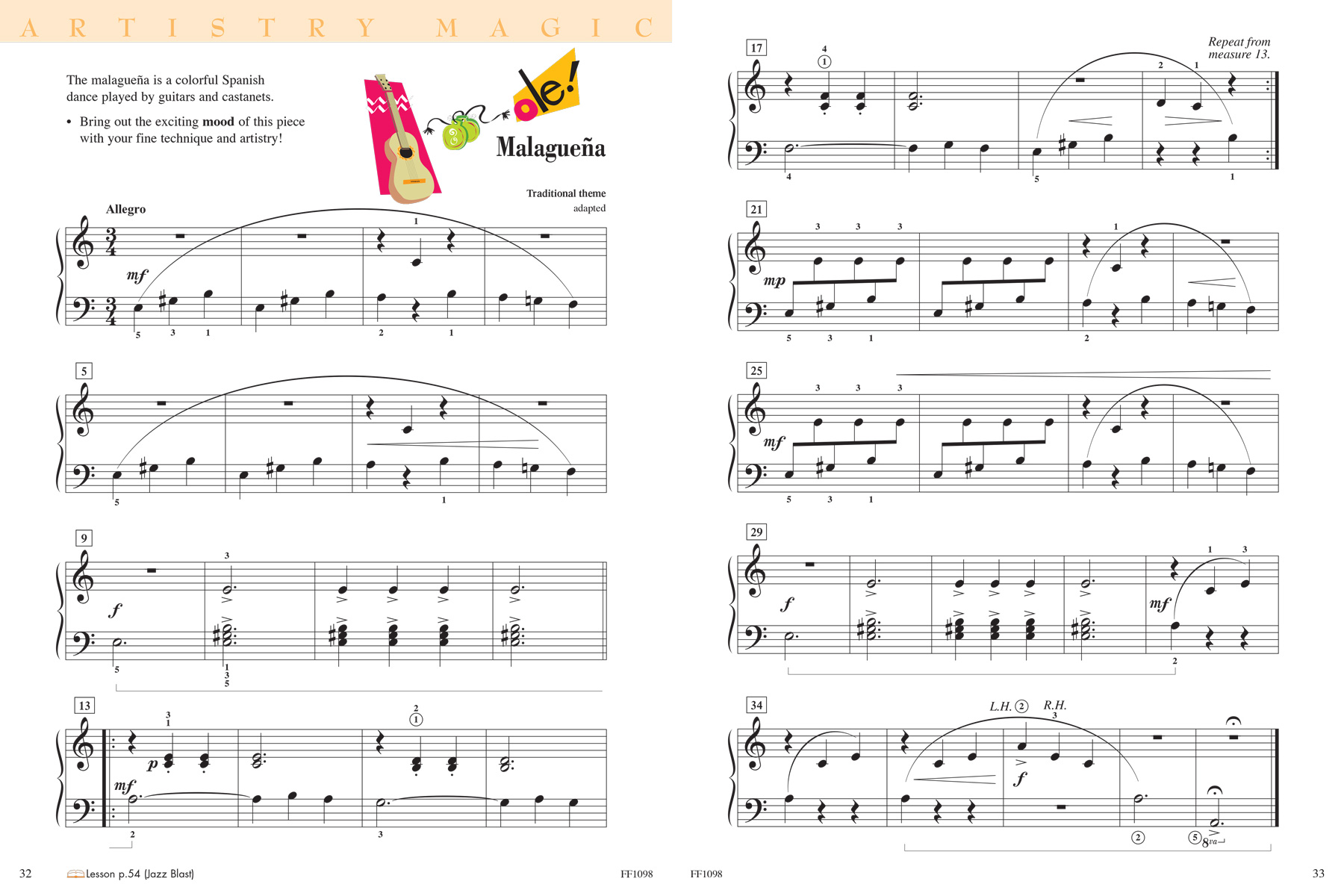
Level 2A Performance Book
The Loch Ness Monster (pp. 14-15)

10. How is the L.H. developed in Level 2A?
Left hand development begins to expand at Level 2A with a greater use of finger independence, L.H. melodies, blocked chords, and ostinato/boogie bass pattern.
Level 2A Lesson Book: finger independence
Ode to Joy (pp. 24-25)

Level 2A Lesson Book: L.H. melody
I Am the King (p. 26)

Level 2A Lesson Book: blocked chords
The Queen’s Royal Entrance (pp. 40-41)

Level 2A Lesson Book: ostinato/boogie bass pattern
Aardvark Boogie (pp. 44-45)

11. The end of the Lesson Book has a Challenge Section showing all 12 major 5-finger scales. When should a student learn these? (pp. 62-63)
The Challenge Section at the end of the 2A Lesson Book features the 12 major 5-finger scales with an “Adventure Warm-up.” This Warm-up presents the 5-finger scale, broken chord, and ends with blocked I and V7 chords. A resource for both teacher and student, it can be integrated at any time in the book.
The major 5-finger scales are colorfully shown with mountaintop illustrations depicting the chord geography.
- Group 1 Keys: C F G (I chords on white keys)
- Group 2 Keys: D A E (I chords with a sharp in the middle)
- Group 3 Keys: D
 A
A E
E (I chords with a flat on the bottom and top)
(I chords with a flat on the bottom and top) - Group 4 Keys: G
 or F
or F , B
, B B (all different!)
B (all different!)
Students can transpose many of the 5-finger major pieces into other keys. This multi-key strategy develops technique, builds the ear, and instills confidence to move around to other keys easily.
A recommended final goal would be to play the “Adventure Warm-up” chromatically up the keys!
Level 2A Lesson Book
Challenge Section (pp. 62-63)

12. What are the Technique Secrets and how do they help?
Technique at the piano requires more than finger muscles. It involves sophisticated body motion between the body, arm, wrist, and finger. We call these motions “technique gestures.”
At each level of Piano Adventures, the student is introduced to level-appropriate Technique Secrets that promote fluent playing while preventing bad habits. These “secrets” are used as daily warm-ups for the exercises that follow in the book. This combination of secrets and exercises leads to an Artistry Magic Piece at the end of each unit. These pieces allow the elementary student to demonstrate artistry based on fine technique learned earlier.
Level 2A Technique & Artistry has 5 Technique Secrets, each with a unique name.
- Firm Fingertips (Finger Inspector)
- Light Thumb (Light as a Feather)
- Fast Fingers (Flying Fingers)
- Hands-Together Coordination (Team Players)
- Wrist Float-off (Moon Walk)
Check out sample videos of Technique Secrets here.
Level 2A Technique & Artistry Book
Five Technique Secrets (pp. 2-3)

13. When should I be using the 2A Sightreading Book and how?
The Level 2A Sightreading Book builds confident elementary readers in two ways: recognition of individual notes and perception of rhythmic and melodic patterns.
The book is organized into sets of 5 exercises, for 5 days of practice. Each set presents variations on a piece from the Level 2A Lesson Book. Play one exercise a day, completing one set per week.
Students may begin the Level 2A Sightreading Book with the very first song in the 2A Lesson Book, “When the Saints Go Marching In.” Introducing sightreading early in instruction allows the formation of an important principle: Notes that do not change their location on the staff are integrated into compositional patterns that do change. Permanence and change come together for musical literacy.
Here are several ways to use the Level 2A Sightreading Book.
- Teachers listen to the sightreading example for just “Day 1” at the lesson. Assign the next pages of the 5-day set to sightread at home. At the following lesson, the teacher might choose one sample “Day” from that set to hear. Then assign the next set.
- If teaching 30-minute lessons, teachers might consider using the Sightreading Book in place of the Performance Book.
- Some teachers enjoy using the Sightreading Book at the lesson to introduce a new note or piece. The student then learns the correlating Lesson Book piece at home as an independent study.
- The Sightreading Book can be used as a final end-of-level project. Before starting Level 2B, take several weeks to assign multiple pages of the 2A Sightreading Book, along with a ShowTime Book. Students can enjoy a change of pace in their practice routine, while celebrating all the notes they have learned.
- Note: For reading support, Piano Adventures Flashcards are also available and span the Primer through Level 2A.
Level 2A Sightreading Book
Chart Your Progress (pp. 2-3)

When the Saints Go Marching In (pp. 6-9)


About Level 2A Students
14. Do students compose and improvise at Level 2A?
There are many opportunities to compose and improvise in Level 2A. These activities are integrated throughout the level and bring support to new concepts.
Level 2A Lesson Book: Special endings spark student creativity.
Leftover Popcorn (Creative Activity, p. 13)
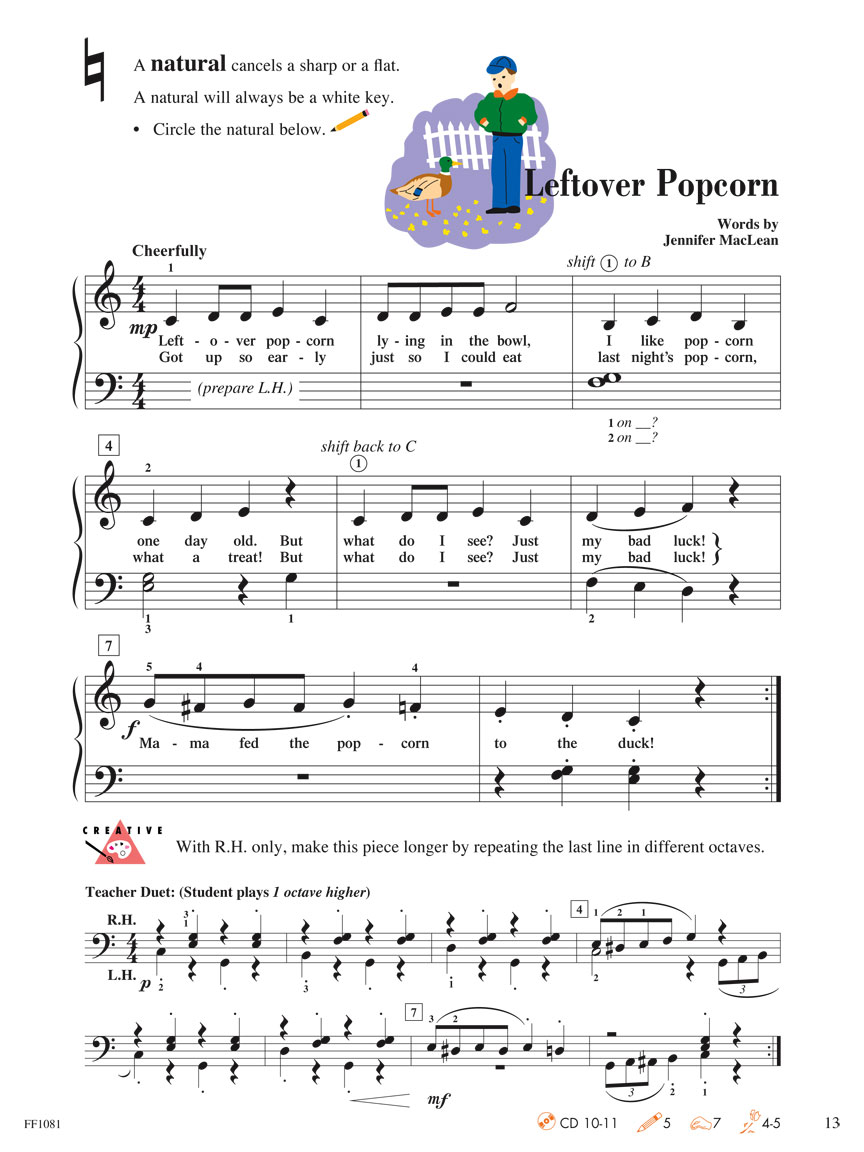
The Clock Strikes Thirteen! (m. 9, p. 22)

Level 2A Lesson Book: Students create harmony with lead sheets.
Lead Sheet for Go Tell Aunt Rhodie (pp. 58-59)

Level 2A Theory Book: The “phrase” helps students compose.
If You Meet an Alligator (p. 19)

Level 2A Theory Book: Students improvise with major/minor 5-finger scales.
Whirling Leaves Improv (p. 32)
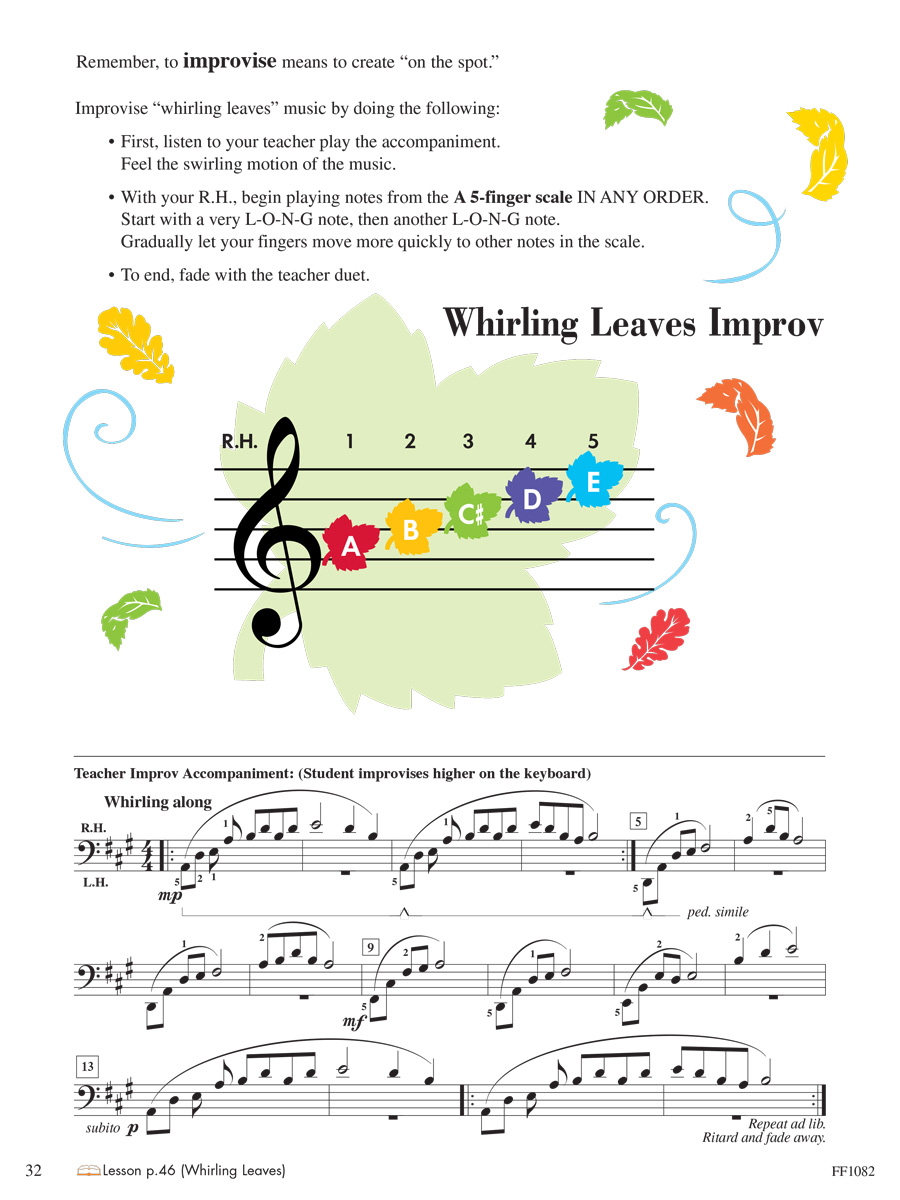
15. What if a student has a poor sense of rhythm?
If a student has a poor sense of rhythm, here are fun things to do.
- First, be sure the student can keep a steady beat in a simple setting, then a more complex setting. Set the tempo and have the student clap a steady beat while the teacher plays the student piece. Then have the student clap a steady beat while the teacher plays the Teacher Duet to the same song. Simple rhythm to a more complex rhythm.
- Use rhythm instruments to play the rhythm of the song. Many students especially enjoy playing the xylophone.
- At Level 2A, many rhythmic errors involve “sailing through” half notes and whole notes, not giving them their full value. Rather than the teacher writing the counts in, have the student do the writing.
The other challenge is a less-than-smooth 8th-note rhythm pattern. Imitation of the teacher to imprint the “sound pattern” in the student’s ear works wonders.
- Playing the Teacher Duets creates an interesting rhythmic background while the student demonstrates rhythmic independence.
16. What pieces could a 2A student play for extra fun?
For extra Level 2A fun, the ShowTime Piano Books offer great repertoire. The ShowTime Books have a variety of styles with many familiar songs. A student could start a ShowTime Book at the end of Unit 1 in the 2A Lesson Book.

ShowTime Piano Books provide effective supplementary repertoire in 3 ways:
- They help confirm a clear understanding of basic rhythms with 8th notes.
- They offer great reinforcement of note and intervallic reading.
- They prepare the student for a smooth transition into Level 2B.
See books and song titles for the ShowTime Piano Books.
Level 2A students may also enjoy the 2A Gold Star Performance Book (great for recitals), and the Piano Adventures Level 2A Christmas Book. Various Level 2A Sheets are also available.
17. How important are recitals?
Recitals can be an exciting event for the Level 2A student. Recitals may also be intimidating. Students often form memories of their recitals. So, making it friendly, upbeat, and fun is keenly important.
- Consider calling the recital, “The Piano Party.” Great music, great treats, great fun!
- Consider playing one piece with a duet for the Level 2A student. Your composure will transfer to the student. Then the student might play one piece as a “solo.”
- As the recital approaches and students are polishing their pieces, have a “practice performance” with the student by sitting across the room. The student practices walking in, seating themselves with hands in lap, thinking the tempo in their head, placing hands carefully in position, and beginning the piece. When done, practice taking a bow, smiling, and leaving the piano.
- “Practice performances” can also be done in a small group session with the teacher. If this is done several weeks before the actual event, a good outcome is almost certain. Poise must be practiced!
- Lastly, as “The Piano Party” begins, consider giving the parents a big “thank you” for supporting their child’s music education. And then cheerfully ask the audience to clap enthusiastically for each performer. Shouting “bravo” is fine!
Practice this with the audience. “Your children have worked very hard this year. Let’s practice clapping for the young performers before we begin. Give it your all. Ready, go!” (Begin the clapping with gusto to set the tone.) Kids will get a big kick out of this and it primes everyone to relax and have a good time. Then the recital can begin.

18. Can I teach Level 2A students in an online lesson? What are some teaching tips?
Yes, it is completely possible to teach Level 2A core books in an online lesson, such as Zoom.
The best way to do this is through subscribing to the Teacher Atlas and using its screen-sharing capability. All books in the Faber Library are available for viewing and screen sharing—including the Level 1 method books and the supplementary ShowTime Piano Books.
Here are some ideas for teaching the Level 2A Lesson Book in an online lesson.
NOTE: Have the student become very familiar with the music before playing. Accomplish this through questions that require active responses from the student. Keep the discussion light, upbeat, and “congratulatory” as the student answers.
Let’s apply this to the first Unit 1 piece, “Awesome Creatures.” These are sample ideas. Teachers can create original questions and responses.
Level 2A Lesson Book
Awesome Creatures (p. 11)

Sample Online Questions for “Awesome Creatures”
- Let’s review our three 8th note patterns at the bottom of page 10.
Pattern 1 is a quarter note and two 8th notes. Tap and say after me.
teacher: TA ti-ti student copies: TA ti-ti
“Very good!”
- Pattern 2 reverses the notes—two 8th notes and a quarter note.
Tap and say after me.
teacher: ti-ti TA student copies: ti-ti TA
“Very good again!”
- Now look at “Awesome Creatures.” Does line 1 have any 8th notes? What are these notes called?
“Right. They are all quarter notes”
- Look carefully at line 2. Are the 8th notes here pattern 1 or pattern 2?
“Excellent, pattern 2.”
- Let’s go back to the bottom of p. 10. Pattern 3 shows four 8th notes all beamed together. Tap and say after me.
teacher: ti-ti-ti-ti student copies: ti-ti-ti-ti
- Now look at line 3 of “Awesome Creatures”? Is that pattern 3?
“Indeed, it is.”
- I’m going to play and sing the piece while you watch the music. The words help us feel the 8th notes. (Do)
“Now it’s your turn!
- Set a steady beat with your 2 measures of quarter notes.
“Good playing!
- To end our time on this piece, I’ll name an animal. You tell me if the 8th note pattern is pattern 1, 2, or 3. Here’s the first one.
Kit – ty cat
“Yes, pattern 2!”
BIG__ hip-po
“Yes, pattern 1!”
Ar-ma-dil-lo
“Yes, pattern 3!”
- This week as you practice “Awesome Creatures”, you might like to think of other animals to substitute for some of the words. Have fun!
About Level 2A Adventure Learning Videos
19. What are the Adventure Learning Videos?
These videos feature close-ups of the hands with simple text that taps the student’s “musical mind” with theory analysis and technique tips.
The Adventure Learning Videos for Level 2A are currently in progress and should be completed at the end of 2022. They can be very useful in a variety of ways and are modeled after the Primer Adventure Learning Videos.
About Level 2A Audio Files
20. What are the audio files and how could I use them?
Orchestrated accompaniments for Level 2A pieces are available in the Audio Cloud and Piano Adventures Player app. Have fun exploring with your students!
Preview a track a week before teaching it at the lesson. As you listen together, discuss the sound. Is the piece happy or sad? Is the tempo fast or slow? Can you name one of the instruments that is playing?
Playing with a background accompaniment demands correct rhythm, and can be more fun than using a metronome. Students learn to feel the meter and understand the need to “keep going.” Demonstrate with the practice tempo track and point to each note in time, or chant the lyrics, finger numbers, or note names.
Many of the accompaniments encourage free improvisation on the black or white keys. These extra measures offer opportunities to create original sounds.
The musical vignettes in this series introduce the student to a variety of musical sounds and ensembles, such as the marching band, chamber orchestra, jazz ensemble, rock band, and more. Which styles are your favorites?


